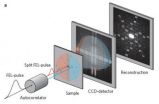(Press-News.org) Major power outages are fairly infrequent, but when they happen they can result in billions of dollars in costs – and even contribute to fatalities. Now research from North Carolina State University has led to the development of an approach by which high-resolution power-system measurements, also referred to as Synchrophasors, can be efficiently used to develop reliable models of large power systems, which would help us keep an eye on their health.
Synchrophasors are real-time measurements of voltages and currents that provide a very high-resolution view of various complex events occurring in a power system. They are measured by sophisticated digital recording devices called phasor measurement units (PMUs). "PMUs are comparable to surveillance cameras that continuously monitor the complex dynamics of groups of people in busy places, and indicate how different people respond and interact with each other," says Dr. Aranya Chakrabortty, lead author of a paper describing the research and an assistant professor of electrical and computer engineering at NC State.
"This research is a major step toward helping us understand how Synchrophasor technology can be used to model the complex behavior of any large, geographically distributed power system, especially taking into account the system's interconnected nature," Chakrabortty says.
"We need to have a better understanding of how a disturbance entering one generation cluster – or localized group of nodes – may spread across the entire system, creating havoc in its neighboring clusters as well," Chakrabortty says. "More importantly, we need to investigate if the speed of this spread is dictated by the way these clusters are connected to each other." The North American power grid is divided into four distinct operating zones, each of which has several such generation pockets, Chakrabortty explains, across which a disturbance can disseminate very easily.
For example, during the 2003 Northeast Blackout, generating units in Ohio and New England appeared to be functioning smoothly. However, there was significant disparity between the two regions when it came to reactive power – which is a byproduct of generating electricity. That disparity created a cascading series of "voltage collapse" events – which cut off power to approximately 50 million people, was linked to multiple fatalities and cost an estimated $4 to 10 billion. The event highlighted the need for monitoring the system globally, rather than focusing on individual nodes in isolation.
"In order to understand how the effects of major disturbances can propagate across the North American power system, we need highly reliable and rigorous mathematical models that capture the dynamics of its various clusters, as well as the way those dynamics will evolve when the clusters are connected to each other in the overall system," Chakrabortty says. "Traditional measurement methods in power systems are too slow and, therefore, incapable of capturing these dynamics, which can change dramatically in fractions of a second. With the Synchrophasor technology today such models are possible."
Chakrabortty and his co-authors from Rensselaer Polytechnic Institute (RPI) and Southern California Edison have developed an approach for creating cluster models, which uses Synchrophasors from PMUs located at specific points within a cluster of nodes. The approach also allows one to identify how the clusters are connected to each other by comparing PMU measurements at different points in the system. "Once you have modeled the clusters and determined their connections," Chakrabortty says, "our algorithm enables you to model the interactive behavior of the clusters within the larger system in the face of large disturbances. We also show how to place PMUs optimally at the nodes so as to extract maximum amount of useful information for better modeling.
"Our models are informative, yet easy to compute," Chakrabortty adds. "They will help power-system operators track and predict the global health of any distributed power system in real time so that catastrophes such as the 2003 blackout can be prevented in the future. The study will lead to an entirely new vision of monitoring and controlling the North American grid, which is becoming more expansive, and, more chaotic day by day."
INFORMATION:
The paper, "A Measurement-based Framework for Dynamic Equivalencing of Large Power Systems using Wide-Area Phasor Measurements," was co-authored by Dr. Joe Chow of RPI and Armando Salazar of Southern California Edison. The paper is published online in IEEE Transactions on Smart Grid. The research was partly funded by the Power System Research Consortium, and is currently being extended at NC State under the support of the National Science Foundation.
New approach to modeling power system aims for better monitoring and control of blackouts
2011-01-13
ELSE PRESS RELEASES FROM THIS DATE:
People neglect who they really are when predicting their own future happiness
2011-01-13
Humans are notoriously bad at predicting their future happiness. A new study published in Psychological Science, a journal of the Association for Psychological Science, suggests that part of the reason for these mispredictions lies in failing to recognize the key role played by one's own personality when determining future emotional reactions.
The new evidence comes from Jordi Quoidbach, a psychological scientist at the University of Liege, Belgium. Quoidbach and Elizabeth Dunn, his collaborator at the University of British Columbia, found that our natural sunny or negative ...
Fastest movie in the world recorded
2011-01-13
When we catch a cold, the immune system steps in to defend us. This is a well-known biological fact, but is difficult to observe directly. Processes at a molecular level are not only miniscule, they are often extremely fast, and therefore difficult to capture in action. Scientists at Helmholtz-Zentrum Berlin für Materialien und Energie (HZB) and the Technische Uni-versität Berlin (TUB) now present a method that takes us a good step towards producing a "molecular movie". They can record two pictures at such a short time interval that it will soon be possible to observe molecules ...
Sleep-disordered breathing comes at a heavy cost
2011-01-13
"Snoring, sleep apnoea, and obesity-related respiratory difficulties are fairly common disorders that affect a large proportion of the population," according to Poul Jennum, Professor of Clinical Neurophysiology at the Center for Healthy Ageing at the University of Copenhagen Faculty of Health Sciences. He is head of the Danish Centre for Sleep Medicine, Glostrup Hospital, which treats patients from all over the country.
"Previous studies show that these disorders seriously affect quality of life, and our new studies show that people who snore violently, and particularly ...
'Yo-yo' effect of slimming diets explained
2011-01-13
If you want to lose the kilos you've put on over Christmas, you may be interested in knowing that the hormones related to appetite play an important role in your likelihood of regaining weight after dieting. A new study confirms that people with the highest levels of leptin and lowest levels of ghrelin are more likely to put the centimetres they lost back on again.
Doctors often have to deal with patients who, after sticking to a slimming diet, have regained the kilos lost in just a short time – or weigh even more than they did before they started the diet. This is called ...
Drug reduces the increase in fear caused by previous traumatic experiences in mice
2011-01-13
Mice previously exposed to traumatic situations demonstrate a more persistent memory of fear conditioning - acquired by associating an acoustic stimulus with an aversive stimulus - and lack the ability to inhibit this fear. This phenomenon is similar to that of people who suffer from Post-Traumatic Stress Disorder (PTSD), an anxiety disorder which appears after being exposed to highly traumatic situations, such as a violent attack, a natural disaster or physical abuse.
In the study researchers verified that the 7,8-Dihydroxyflavone injected into mice previously subjected ...
Cosmic magnifying lenses distort view of distant galaxies
2011-01-13
Looking deep into space, and literally peering back in time, is like experiencing the universe in a house of mirrors where everything is distorted through a phenomenon called gravitational lensing. Gravitational lensing occurs when light from a distant object is distorted by a massive object that is in the foreground. Astronomers have started to apply this concept in a new way to determine the number of very distant galaxies and to measure dark matter in the universe. Though recent progress has been made in extending the use of gravitational lensing, a letter published ...
Researchers show how 1 gene becomes 2 (with different functions)
2011-01-13
CHAMPAIGN, Ill. — Researchers report that they are the first to show in molecular detail how one gene evolved two competing functions that eventually split up – via gene duplication – to pursue their separate destinies.
The study, in the Proceedings of the National Academy of Sciences, validates a decades-old hypothesis about a key mechanism of evolution. The study also confirms the ancestry of a family of "antifreeze proteins" that helps the Antarctic eelpout survive in the frigid waters of the Southern Ocean.
"I'm always asking the question of where these antifreeze ...
MicroRNAs could increase the risk of amputation in diabetics
2011-01-13
New research has found one of the smallest entities in the human genome, micro-RNA, could increase the risk of limb amputation in diabetic patients who have poor blood flow.
The study by Dr Andrea Caporali and colleagues in Professor Costanza Emanueli's research group in the Regenerative Medicine Section of the School of Clinical Sciences at the University of Bristol was funded by the Medical Research Council and is published online in Circulation: Journal of the American Heart Association.
The research group have shown in an experimental cell study that conditions ...
Some school social workers don't feel prepared to manage cyberbullying, study finds
2011-01-13
ATHENS, Ohio (Jan. 12, 2011) – Some school social workers report that they don't feel equipped to handle incidents of cyberbullying among teens.
A new Ohio University-led survey of 399 members of the 11-state Midwest School Social Work Council found that while nearly all agreed that cyberbullying can cause psychological harm— including suicide—and deserved more attention from schools, just more than half felt empowered to deal with the issue. In contrast, other research on traditional bullying suggests that 86 percent of school staff members are confident in their ability ...
Hold the Red Bull: Energy drinks don't blunt effects of alcohol, study finds
2011-01-13
Marketing efforts that encourage mixing caffeinated "energy" drinks with alcohol often try to sway young people to believe that caffeine will offset the sedating effects of alcohol and increase alertness and stamina.
But a new study led by researchers from the Boston University School of Public Health [BUSPH] and the Center for Alcohol and Addiction Studies at Brown University has found that the addition of caffeine to alcohol -- mixing Red Bull with vodka, for example -- has no effect on enhancing performance on a driving test or improving sustained attention or reaction ...



